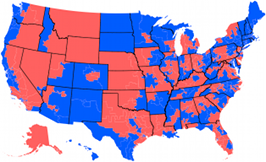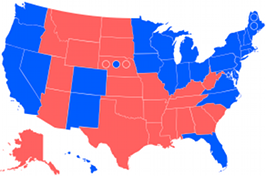It seems like most of the third party and independent spoilers this year are harming Democrats, but the Constitution Party’s Tom Tancredo is clearly hurting Republican Dan Maes in the Colorado Governor’s race, currently throwing the lead to Democrat John Hickenlooper.
But two new polls on that race, from Magellan Strategies via Real Clear Politics and Rasmussen Reports are so different that I think we need to see why that is.
[More]
I’ve had my ups and downs with Gallup (one might say the relationship is like the plot of the Gallup generic ballot itself!), but since they’ve been solidly running registered voter surveys again, the numbers have looked reasonable.
But now they’re shocking us from the other direction by showing the Republicans having their largest ever lead in the generic ballot survey, showing a larger edge than even today’s Rasmussen’s GOP +6 (notwithstanding the alleged House Effect of the latter).
[More]
The Florida primaries are today, but I’m not posting on them today. That way I have time to address – by popular demand* – all the new generic ballot polls, and see where the Swingometer is landing lately.
As always, I’m using the trusty Real Clear Politics archives to find the polls. So let’s go.
[More]
I theorized before that Pat Quinn would drag down Alexi Giannoulias in Illinois, with a rout for Governor having reverse coattails for Senate, and now Public Policy Polling seems to show the effects I predicted.
A bad candidate for governor in a negative wave year is a terrible situation for a party to have, but that’s the Democrats in Illinois today.
[More]
Two major pollsters have announced changes to their methods as we get nearer to election day. Both of these should bring shifts in the polls which may strike us as sudden or dramatic, so be aware.
[More]
Just as I make my last post talking about a trend in the Florida Senate polling, Ipsos’ new poll for the St. Petersburg Times shows the opposite result.
[More]
With the help of the Real Clear Politics, here are the last few polls of the Kentucky Senate race. PPP: Randal Paul +1. RR: Paul +25. SUSA: Paul +6. RR: Paul +8, Paul +7. And now we have PPP: Tie.
Why is PPP running so much further toward Jack Conway than the other two pollsters?
[More]
Rasmussen polled the Pennsylvania Senate race again, and Pat Toomey still leads.
Can Sestak break through and get another surge like his post-primary unity bounce?
[More]
I’ve been saying that the results in North Carolina would be a clear decider between the Rasmussen and PPP likely voter models. New polling has made the difference less dramatic, thanks to a Burr surge, but the difference is still there.
[More]
Are we tired of Pennsylvania yet? Of course not! Specifically we now check in on the Governor’s race. Rasmussen has released the first poll since the primary, but I will compare that with the last pre-primary Quinnipiac poll anyway. Tom Corbett and Dan Onorato were obvious likely nominees.
I believe we have as much to learn about Rasmussen’s distinctive modeling as we do about the race itself.
[More]
In the North Carolina Senate race we already saw that Rasmussen Reports and Public Policy Polling are showing markedly different figures.
It looks like we’re going to see the same contrast in the Colorado Senate race, as Rasmussen showed Republicans doing well while PPP shows Democrats ahead.
[More]
One race: North Carolina Senate general between Republican Richard Burr and prospective Democrats Cal Cunningham and Elaine Marshall. Two polls: Public Policy Polling and Rasmussen Reports. Two markedly different results: Rasmussen shows Burr nearly 10 points higher than PPP does.
What’s going on?
[More]
When I see people, and particularly conservatives, discussing why one poll is better than another, I see the sample pool frequently cited as a reason for favoring one or another. Specifically, some poll watchers insist that any poll not filtered for likely voters, instead of just registered voters or even adults, is not useful in a political context.
The dirty secret is that not all likely voters are created equal. Every pollster has his own secret sauce, and we have to be careful when trusting that kind of filtering. It might not be what we expect.
[More]


 House of Representatives Swingometer
House of Representatives Swingometer Electoral College Swingometer
Electoral College Swingometer